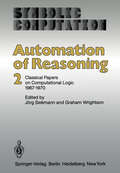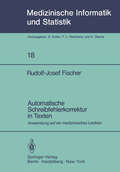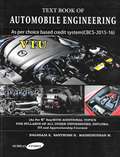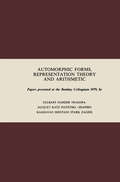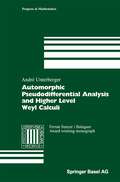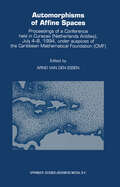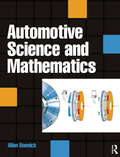- Table View
- List View
Automation of Reasoning: 2: Classical Papers on Computational Logic 1967–1970 (Symbolic Computation)
by J. Siekmann G. Wrightson"Kind of crude, but it works, boy, it works!" AZan NeweZZ to Herb Simon, Christmas 1955 In 1954 a computer program produced what appears to be the first computer generated mathematical proof: Written by M. Davis at the Institute of Advanced Studies, USA, it proved a number theoretic theorem in Presburger Arithmetic. Christmas 1955 heralded a computer program which generated the first proofs of some propositions of Principia Mathematica, developed by A. Newell, J. Shaw, and H. Simon at RAND Corporation, USA. In Sweden, H. Prawitz, D. Prawitz, and N. Voghera produced the first general program for the full first order predicate calculus to prove mathematical theorems; their computer proofs were obtained around 1957 and 1958, about the same time that H. Gelernter finished a computer program to prove simple high school geometry theorems. Since the field of computational logic (or automated theorem proving) is emerging from the ivory tower of academic research into real world applications, asserting also a definite place in many university curricula, we feel the time has corne to examine and evaluate its history. The article by Martin Davis in the first of this series of volumes traces the most influential ideas back to the 'prehistory' of early logical thought showing how these ideas influenced the underlying concepts of most early automatic theorem proving programs.
Automatische Schreibfehlerkorrektur in Texten: Anwendung auf ein medizinisches Lexikon (Medizinische Informatik, Biometrie und Epidemiologie #18)
by R.-J. FischerAutomobile Engineering for Sixth Semester Mechanical Engineering
by Nagaraja S Santhosh N Madhusudhan M.Automobile Engineering is a branch of study which teaches manufacturing, designing, mechanical mechanisms as well as the specific operations of automobiles. It is an introduction to vehicle engineering which deals with motorcycles, cars, buses trucks etc. It includes domain specific knowledge of mechanical, electronic, software and safety elements.The text book contains neat sketches and salient points to help students and readers understand the principles of automobile engineering. The theoretical questions are included at the end of each module to make the book a complete unit in all aspects.
Automorphe Formen (Masterclass)
by Anton DeitmarDas Buch bietet eine Einführung in die Theorie der automorphen Formen. Beginnend bei klassischen Modulformen führt der Autor seine Leser hin zur modernen, darstellungstheoretischen Beschreibung von automorphen Formen und ihren L-Funktionen. Das Hauptgewicht legt er auf den Übergang von der klassischen, elementaren Sichtweise zu der modernen, durch die Darstellungstheorie begründete Herangehensweise. Diese Art der Verbindung von klassischer und moderner Sichtweise war in der Lehrbuchliteratur bisher nicht zu finden.
Automorphe Funktionen und indefinite quadratische Formen (Sitzungsberichte der Heidelberger Akademie der Wissenschaften #1949 / 1)
by Hans MaassAutomorphic Forms (Universitext)
by Anton DeitmarAutomorphic forms are an important complex analytic tool in number theory and modern arithmetic geometry. They played for example a vital role in Andrew Wiles's proof of Fermat's Last Theorem. This text provides a concise introduction to the world of automorphic forms using two approaches: the classic elementary theory and the modern point of view of adeles and representation theory. The reader will learn the important aims and results of the theory by focussing on its essential aspects and restricting it to the 'base field' of rational numbers. Students interested for example in arithmetic geometry or number theory will find that this book provides an optimal and easily accessible introduction into this topic.
Automorphic Forms: Research in Number Theory from Oman (Springer Proceedings in Mathematics & Statistics #115)
by Bernhard Heim Mehiddin Al-Baali Tomoyoshi Ibukiyama Florian RuppThis edited volume presents a collection of carefully refereed articles covering the latest advances in Automorphic Forms and Number Theory, that were primarily developed from presentations given at the 2012 “International Conference on Automorphic Forms and Number Theory,” held in Muscat, Sultanate of Oman. The present volume includes original research as well as some surveys and outlines of research altogether providing a contemporary snapshot on the latest activities in the field and covering the topics of:Borcherds productsCongruences and CodesJacobi formsSiegel and Hermitian modular formsSpecial values of L-seriesRecently, the Sultanate of Oman became a member of the International Mathematical Society. In view of this development, the conference provided the platform for scientific exchange and collaboration between scientists of different countries from all over the world. In particular, an opportunity was established for a close exchange between scientists and students of Germany, Oman, and Japan. The conference was hosted by the Sultan Qaboos University and the German University of Technology in Oman.
Automorphic Forms and Even Unimodular Lattices: Kneser Neighbors of Niemeier Lattices (Ergebnisse der Mathematik und ihrer Grenzgebiete. 3. Folge / A Series of Modern Surveys in Mathematics #69)
by Gaëtan Chenevier Jean LannesThis book includes a self-contained approach of the general theory of quadratic forms and integral Euclidean lattices, as well as a presentation of the theory of automorphic forms and Langlands' conjectures, ranging from the first definitions to the recent and deep classification results due to James Arthur.Its connecting thread is a question about lattices of rank 24: the problem of p-neighborhoods between Niemeier lattices. This question, whose expression is quite elementary, is in fact very natural from the automorphic point of view, and turns out to be surprisingly intriguing. We explain how the new advances in the Langlands program mentioned above pave the way for a solution. This study proves to be very rich, leading us to classical themes such as theta series, Siegel modular forms, the triality principle, L-functions and congruences between Galois representations.This monograph is intended for any mathematician with an interest in Euclidean lattices, automorphic forms or number theory. A large part of it is meant to be accessible to non-specialists.
Automorphic Forms and Lie Superalgebras (Algebra and Applications #5)
by Urmie RayThis book provides the reader with the tools to understand the ongoing classification and construction project of Lie superalgebras. It presents the material in as simple terms as possible. Coverage specifically details Borcherds-Kac-Moody superalgebras. The book examines the link between the above class of Lie superalgebras and automorphic form and explains their construction from lattice vertex algebras. It also includes all necessary background information.
Automorphic Forms on Adele Groups. (AM-83), Volume 83 (PDF)
by Stephen S. GelbartThis volume investigates the interplay between the classical theory of automorphic forms and the modern theory of representations of adele groups. Interpreting important recent contributions of Jacquet and Langlands, the author presents new and previously inaccessible results, and systematically develops explicit consequences and connections with the classical theory. The underlying theme is the decomposition of the regular representation of the adele group of GL(2). A detailed proof of the celebrated trace formula of Selberg is included, with a discussion of the possible range of applicability of this formula. Throughout the work the author emphasizes new examples and problems that remain open within the general theory. TABLE OF CONTENTS: 1. The Classical Theory 2. Automorphic Forms and the Decomposition of L2(PSL(2,R) 3. Automorphic Forms as Functions on the Adele Group of GL(2) 4. The Representations of GL(2) over Local and Global Fields 5. Cusp Forms and Representations of the Adele Group of GL(2) 6. Hecke Theory for GL(2) 7. The Construction of a Special Class of Automorphic Forms 8. Eisenstein Series and the Continuous Spectrum 9. The Trace Formula for GL(2) 10. Automorphic Forms on a Quaternion Algebr?
Automorphic Forms on Semisimple Lie Groups (Lecture Notes in Mathematics #62)
by Bhartendu HarishchandraAutomorphic Forms, Representation Theory and Arithmetic: Papers presented at the Bombay Colloquium 1979 (Tata Institute Studies in Mathematics)
by S. Gelbart G. Harder K. Iwasawa H. Jaquet N.M. Katz I. Piatetski-Shapiro S. Raghavan T. Shintani H.M. Stark D. ZagierInternational Colloquium an Automorphic Forms, Representation Theory and Arithmetic. Published for the Tata Institute of Fundamental Research, Bombay
Automorphic Pseudodifferential Analysis and Higher Level Weyl Calculi (Progress in Mathematics #209)
by André UnterbergerAutomorphic Representation of Unitary Groups in Three Variables. (AM-123), Volume 123 (PDF)
by Jonathan David RogawskiThe purpose of this book is to develop the stable trace formula for unitary groups in three variables. The stable trace formula is then applied to obtain a classification of automorphic representations. This work represents the first case in which the stable trace formula has been worked out beyond the case of SL (2) and related groups. Many phenomena which will appear in the general case present themselves already for these unitary groups.
Automorphism Groups of Compact Bordered Klein Surfaces: A Combinatorial Approach (Lecture Notes in Mathematics #1439)
by Emilio Bujalance Jose J. Etayo Jose M. Gamboa Grzegorz GromadzkiThis research monograph provides a self-contained approach to the problem of determining the conditions under which a compact bordered Klein surface S and a finite group G exist, such that G acts as a group of automorphisms in S. The cases dealt with here take G cyclic, abelian, nilpotent or supersoluble and S hyperelliptic or with connected boundary. No advanced knowledge of group theory or hyperbolic geometry is required and three introductory chapters provide as much background as necessary on non-euclidean crystallographic groups. The graduate reader thus finds here an easy access to current research in this area as well as several new results obtained by means of the same unified approach.
Automorphisms and Derivations of Associative Rings (Mathematics and its Applications #69)
by V. KharchenkoAutomorphisms in Birational and Affine Geometry: Levico Terme, Italy, October 2012 (Springer Proceedings in Mathematics & Statistics #79)
by Ivan Cheltsov Ciro Ciliberto Hubert Flenner James McKernan Yuri G. Prokhorov Mikhail ZaidenbergThe main focus of this volume is on the problem of describing the automorphism groups of affine and projective varieties, a classical subject in algebraic geometry where, in both cases, the automorphism group is often infinite dimensional. The collection covers a wide range of topics and is intended for researchers in the fields of classical algebraic geometry and birational geometry (Cremona groups) as well as affine geometry with an emphasis on algebraic group actions and automorphism groups. It presents original research and surveys and provides a valuable overview of the current state of the art in these topics.Bringing together specialists from projective, birational algebraic geometry and affine and complex algebraic geometry, including Mori theory and algebraic group actions, this book is the result of ensuing talks and discussions from the conference “Groups of Automorphisms in Birational and Affine Geometry” held in October 2012, at the CIRM, Levico Terme, Italy. The talks at the conference highlighted the close connections between the above-mentioned areas and promoted the exchange of knowledge and methods from adjacent fields.
Automorphisms of Affine Spaces
by Arno Van Den EssenAutomorphisms of Affine Spaces describes the latest results concerning several conjectures related to polynomial automorphisms: the Jacobian, real Jacobian, Markus-Yamabe, Linearization and tame generators conjectures. Group actions and dynamical systems play a dominant role. Several contributions are of an expository nature, containing the latest results obtained by the leaders in the field. The book also contains a concise introduction to the subject of invertible polynomial maps which formed the basis of seven lectures given by the editor prior to the main conference. Audience: A good introduction for graduate students and research mathematicians interested in invertible polynomial maps.
Automorphisms of Finite Groups (Springer Monographs in Mathematics)
by Inder Bir Passi Mahender Singh Manoj Kumar YadavThe book describes developments on some well-known problems regarding the relationship between orders of finite groups and that of their automorphism groups. It is broadly divided into three parts: the first part offers an exposition of the fundamental exact sequence of Wells that relates automorphisms, derivations and cohomology of groups, along with some interesting applications of the sequence. The second part offers an account of important developments on a conjecture that a finite group has at least a prescribed number of automorphisms if the order of the group is sufficiently large. A non-abelian group of prime-power order is said to have divisibility property if its order divides that of its automorphism group. The final part of the book discusses the literature on divisibility property of groups culminating in the existence of groups without this property. Unifying various ideas developed over the years, this largely self-contained book includes results that are either proved or with complete references provided. It is aimed at researchers working in group theory, in particular, graduate students in algebra.
Automotive Science and Mathematics
by Allan BonnickAutomotive technicians and students need a firm grasp of science and technology in order to fully appreciate and understand how mechanisms and systems of modern vehicles work. Automotive Science and Mathematics presents the necessary principles and applications with all the examples and exercises relating directly to motor vehicle technology and repair, making it easy for automotive students and apprentices to relate the theory back to their working practice.The coverage of this book is based on the syllabus requirements of the BTEC First in Vehicle Technology, BTEC National in Vehicle Repair and Technology, and the IMI Certificate and Diploma in Vehicle Maintenance and Repair, but will help all automotive students and apprentices at levels 2 and 3 and up to and including HNC/HND, foundation and first degree with their studies and in achieving the Key Skill 'Application of Number' at levels 2 and 3. The book is designed to cater for both light and heavy vehicle courses.Full worked solutions of most exercises are available as a free download for lecturers only from http://textbooks.elsevier.com.Allan Bonnick is a motor vehicle education and training consultant and was formerly Head of Motor Vehicle Engineering, Eastbourne College. He is the author of several established automotive engineering textbooks.
Automotive Science and Mathematics
by Allan BonnickAutomotive technicians and students need a firm grasp of science and technology in order to fully appreciate and understand how mechanisms and systems of modern vehicles work. Automotive Science and Mathematics presents the necessary principles and applications with all the examples and exercises relating directly to motor vehicle technology and repair, making it easy for automotive students and apprentices to relate the theory back to their working practice.The coverage of this book is based on the syllabus requirements of the BTEC First in Vehicle Technology, BTEC National in Vehicle Repair and Technology, and the IMI Certificate and Diploma in Vehicle Maintenance and Repair, but will help all automotive students and apprentices at levels 2 and 3 and up to and including HNC/HND, foundation and first degree with their studies and in achieving the Key Skill 'Application of Number' at levels 2 and 3. The book is designed to cater for both light and heavy vehicle courses.Full worked solutions of most exercises are available as a free download for lecturers only from http://textbooks.elsevier.com.Allan Bonnick is a motor vehicle education and training consultant and was formerly Head of Motor Vehicle Engineering, Eastbourne College. He is the author of several established automotive engineering textbooks.
